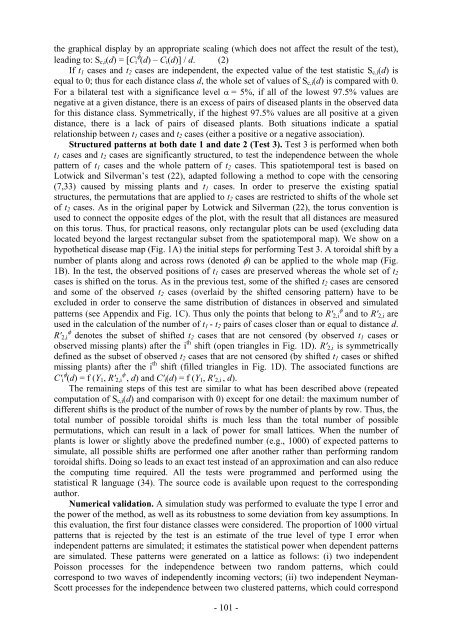Ecole Nationale Supérieure Agronomique de Montpellier ... - CIAM
Ecole Nationale Supérieure Agronomique de Montpellier ... - CIAM
Ecole Nationale Supérieure Agronomique de Montpellier ... - CIAM
Create successful ePaper yourself
Turn your PDF publications into a flip-book with our unique Google optimized e-Paper software.
the graphical display by an appropriate scaling (which does not affect the result of the test),<br />
leading to: Sc,i(d) = [Ci φ (d) – Ci(d)] / d. (2)<br />
If t1 cases and t2 cases are in<strong>de</strong>pen<strong>de</strong>nt, the expected value of the test statistic Sc,i(d) is<br />
equal to 0; thus for each distance class d, the whole set of values of Sc,i(d) is compared with 0.<br />
For a bilateral test with a significance level α = 5%, if all of the lowest 97.5% values are<br />
negative at a given distance, there is an excess of pairs of diseased plants in the observed data<br />
for this distance class. Symmetrically, if the highest 97.5% values are all positive at a given<br />
distance, there is a lack of pairs of diseased plants. Both situations indicate a spatial<br />
relationship between t1 cases and t2 cases (either a positive or a negative association).<br />
Structured patterns at both date 1 and date 2 (Test 3). Test 3 is performed when both<br />
t1 cases and t2 cases are significantly structured, to test the in<strong>de</strong>pen<strong>de</strong>nce between the whole<br />
pattern of t1 cases and the whole pattern of t2 cases. This spatiotemporal test is based on<br />
Lotwick and Silverman’s test (22), adapted following a method to cope with the censoring<br />
(7,33) caused by missing plants and t1 cases. In or<strong>de</strong>r to preserve the existing spatial<br />
structures, the permutations that are applied to t2 cases are restricted to shifts of the whole set<br />
of t2 cases. As in the original paper by Lotwick and Silverman (22), the torus convention is<br />
used to connect the opposite edges of the plot, with the result that all distances are measured<br />
on this torus. Thus, for practical reasons, only rectangular plots can be used (excluding data<br />
located beyond the largest rectangular subset from the spatiotemporal map). We show on a<br />
hypothetical disease map (Fig. 1A) the initial steps for performing Test 3. A toroidal shift by a<br />
number of plants along and across rows (<strong>de</strong>noted φ) can be applied to the whole map (Fig.<br />
1B). In the test, the observed positions of t1 cases are preserved whereas the whole set of t2<br />
cases is shifted on the torus. As in the previous test, some of the shifted t2 cases are censored<br />
and some of the observed t2 cases (overlaid by the shifted censoring pattern) have to be<br />
exclu<strong>de</strong>d in or<strong>de</strong>r to conserve the same distribution of distances in observed and simulated<br />
patterns (see Appendix and Fig. 1C). Thus only the points that belong to R'2,i φ and to R'2,i are<br />
used in the calculation of the number of t1 - t2 pairs of cases closer than or equal to distance d.<br />
R'2,i φ <strong>de</strong>notes the subset of shifted t2 cases that are not censored (by observed t1 cases or<br />
observed missing plants) after the i th shift (open triangles in Fig. 1D). R'2,i is symmetrically<br />
<strong>de</strong>fined as the subset of observed t2 cases that are not censored (by shifted t1 cases or shifted<br />
missing plants) after the i th shift (filled triangles in Fig. 1D). The associated functions are<br />
C'i φ (d) = f (Y1, R'2,i φ , d) and C'i(d) = f (Y1, R'2,i , d).<br />
The remaining steps of this test are similar to what has been <strong>de</strong>scribed above (repeated<br />
computation of Sc,i(d) and comparison with 0) except for one <strong>de</strong>tail: the maximum number of<br />
different shifts is the product of the number of rows by the number of plants by row. Thus, the<br />
total number of possible toroidal shifts is much less than the total number of possible<br />
permutations, which can result in a lack of power for small lattices. When the number of<br />
plants is lower or slightly above the pre<strong>de</strong>fined number (e.g., 1000) of expected patterns to<br />
simulate, all possible shifts are performed one after another rather than performing random<br />
toroidal shifts. Doing so leads to an exact test instead of an approximation and can also reduce<br />
the computing time required. All the tests were programmed and performed using the<br />
statistical R language (34). The source co<strong>de</strong> is available upon request to the corresponding<br />
author.<br />
Numerical validation. A simulation study was performed to evaluate the type I error and<br />
the power of the method, as well as its robustness to some <strong>de</strong>viation from key assumptions. In<br />
this evaluation, the first four distance classes were consi<strong>de</strong>red. The proportion of 1000 virtual<br />
patterns that is rejected by the test is an estimate of the true level of type I error when<br />
in<strong>de</strong>pen<strong>de</strong>nt patterns are simulated; it estimates the statistical power when <strong>de</strong>pen<strong>de</strong>nt patterns<br />
are simulated. These patterns were generated on a lattice as follows: (i) two in<strong>de</strong>pen<strong>de</strong>nt<br />
Poisson processes for the in<strong>de</strong>pen<strong>de</strong>nce between two random patterns, which could<br />
correspond to two waves of in<strong>de</strong>pen<strong>de</strong>ntly incoming vectors; (ii) two in<strong>de</strong>pen<strong>de</strong>nt Neyman-<br />
Scott processes for the in<strong>de</strong>pen<strong>de</strong>nce between two clustered patterns, which could correspond<br />
- 101 -



